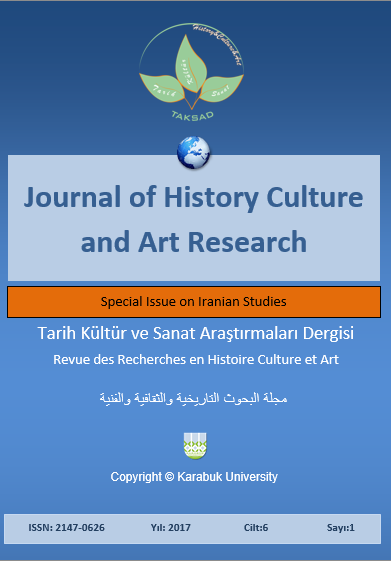Decoding the Symbolic Elements of the Image of Jahangir Embracing Shah Abbas: An Iconological Approach
DOI:
https://doi.org/10.7596/taksad.v6i1.766Keywords:
Iconology, Panofsky, India Mongolian School, King Abbas, Jahangir.Abstract
Noureddine Jahangir (ruling 1605-1627), king of India was one of the tasteful rulers who was interested in dream and its interpretation. He was used to sharing his dreams with others and ask for their opinion about them. He also was used to asking from his reliable painters to picture the dreams. From these images the image of Jahangir Embracing Shah Abbas can be addressed. The purpose of this paper is obtaining hidden deep concept of mentioned image by iconological approach of Erwin Panofsky. Panofsky believes that for recognizing the hidden meanings of artworks, considering the relationship between the details of artwork and general culture and the society that the artwork has gotten formed is necessary. In this paper it is tried to answer to this question: what cultural and political factors did have role in forming the mentioned image? The most important results of this research show that the European Christian elements which had been entered to India Mongolian Painting School was effective. On the other hand the political relations of Iran and India because of the dispute over control of Kandahar was not good.
References
Abdi, Nahid (2011). Introduction to the Iconology of Science: Theory and Applications. Tehran: Sokhan publisher.
Cambridge, Edward (2009). History of Iran, Safavid period, translated by James Azhand, Tehran: Jami.
Cooper, J. C. (2000). Illustrated dictionary of traditional symbols, Translation Maliha Karbassian. Tehran: Farshad Publications.
Crown, Royce (2009). A Brief History of India, translators Farzan Sojoodi, Kaveh Sojoodi, the Academy of Arts of the Islamic Republic of Iran, Tehran.
Deiri, Hosein (2014) The image of "hanging of Mansoor Hallaj" iconological approach in the version of events Alshaq Safavid Shiraz, A visual arts and applied, No. 14, pp. 48-33.
Eliade, Mircea (1997). Treatise on the history of religions, Translation Jalal Stari. Tehran: Soroush Publications.
Falsafi, Nasrollah (1966). The life of first Shah Abbas, Volume 3. Tehran: Negah Institute Publications.
Falsafi, Nasrollah (2011). The life of first Shah Abbas, Volume 1. Tehran: Negah Institute Publications.
Hall, James (2001). Culture of graphic symbols in the art of East and West, Translator Roqiyeh Behzadi, contemporary culture, Tehran.
Hall, James (2004). Culture of graphic symbols in the art of East and West, Translation Roqiyeh Behzadi, contemporary culture, Tehran.
Karimzadeh Tabrizi, Mohammad Ali (1997). Lives and works of old painters of Iran. Tehran: Marvi publishing.
Knight, Jean & Gerber, Alan (2008). Culture of symbols: mythology, dreams, customs, etc., translated by S. virtues. Tehram: Jeyhoon publishing.
Monshi, Ghazi Mir Ahmadi (1987). Golestan of Art. Tehran: Manuchehri.
Moshiri (Bardsir), Mir Mohammad Said (1990). Biography of the Safavid Kerman, introduction and corrected and annotated by Mohammad Ebrahim Bastani Barizi. Tehran: Elm publishing.
Motrebi Samarghandi, Sultan Mehmet (1977). Motrebi memories. Karachi: Abdul Ghani Mirzoyev printing.
Panofsky, Erwin (1955). Meaning in the Visual Arts. New York: Doubleday Anchor Books.
Panofsky, Erwin (1972). Studies in iconology: Humanistic themes in the art of the renaissance, Icon Editions. New York: Harper & Row.
Parsa Dust, M. (2009). The First Shah Abbas, the Kingdom who lessons must be learned from, Volume 1. Tehran: Company publication.
Razpoosh, Sh. (n.d.). Nureddin Mohammad Jahangir, Islam World Encyclopedia, Encyclopaedia Islamica Foundation, Volume 1 P. 5269. lib.eshia.ir
Riyadh al Islam (1994). The History of Relations between Iran and India, Translated by Mohammad Baqer Aram and Abasgholi Ghaffari Fard, Amir Kabir, Tehran.
Rogers, J. M. (2003). Mughal Miniatures, Translation of J. Hashem Zadeh, Tehran: Rich Publication.
Sajadian Mousavi, Jeeran & Gorbani, Hajar (2014). Represents a Sign of Political Culture in the Relations Between India and Iran Painting "Sleeping Image of Jahangir Shah". Proceedings of the First International Conference on Heritage of Iran and India Volume 5, Pp.409-421.
Smith, Vincent A. (1958). The Oxford History of India, ed. Percival Spear, Oxford.
Velayati, A. (1995) On Iran's Foreign Relations During the Reign of Shah Abbas Safavi. Tehran: Printing & Publishing of Foreign Ministry.
Yahaghi, M. J. (2007). Culture, Mythology and Story Schema in Persian Literature Culture. Tehran.
Downloads
Published
How to Cite
Issue
Section
License
All papers licensed under Creative Commons 4.0 CC-BY.- Share — copy and redistribute the material in any medium or format
- Adapt — remix, transform, and build upon the material for any purpose, even commercially.
Under the following terms:
Attribution — You must give appropriate credit, provide a link to the license, and indicate if changes were made. You may do so in any reasonable manner, but not in any way that suggests the licensor endorses you or your use.
- No additional restrictions — You may not apply legal terms or technological measures that legally restrict others from doing anything the license permits.







